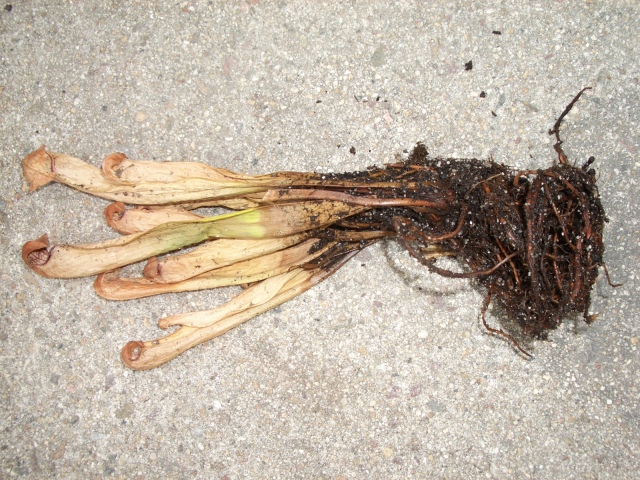Question
 sarracenia minor
sarracenia minor
I bought three S. Minor pitcher plants about a month ago. I transplanted them into a sand/peat mix, which I've used successfully with other Sarracenias, and have them in a greenhouse. Over a week's time, one of the S. Minors suddenly turned all brown and withered. I removed the plant and examined the roots for pests, but I don't see anything unusual. The other S. Minors are doing well. Any ideas? Could this just be transplant shock? Attached is an image of the plant. Thanks for any insight you can give to me. To have this happen so suddenly is quite alarming, to say the least!
AnswerHello Kirk-- It's hard to see from the photo whether the plant's roots have rotted or not. If not, then I would personally plant the S. minor again into a separate pot, to see if it might grow again. I would cut off all the dry parts first, however.
A lot of plants have difficulty supporting their full leaf load immediately after transplanting. At that time, the roots are operating at much less than their former efficiency until they become comfortable and well established in their new medium.
For this reason, many plants (like iris, for example) are often pruned to some extent before they are transplanted. Venus Flytraps often lose a few of their older leaves after transplanting.
If there is no insect pest that affected the plant, and if the roots did not rot, then their inability to keep all the leaves hydrated enough, possibly combined with a lot of direct sunlight and perhaps some hot, dry wind, could perhaps have been responsible, although I'm just guessing at the particular circumstances your plant may have experienced.
The only other reason I have seen for very quick browning and drying of Sarracenia pitchers is when they are overstuffed with insects, when they have caught so many insects in so short a time that they cannot effectively digest and process them all. In that case, a pitcher can turn brown, wrinkle and dry in as little as a week or two. But this usually happens to just one or several pitchers of a plant, not necessarily all of them. So if you examine the dry pitchers and they are not filled with insects, then this is not the cause.
For a more experienced answer, you might ask this same question of the AllExperts expert "Sarracenia Northwest." Jeff Dallas and Jacob Farin (of Sarracenia Northwest) are very experienced with that particular genus (Sarracenia), and much more so than I am.
Members of online carnivorous plant forums may have some excellent comments and advice as well--
FlytrapCare.com Forum
http://FlytrapCare.com/phpBB3/
CPUK Forum
http://CPUKforum.com/
Good luck and best wishes,
Steve






